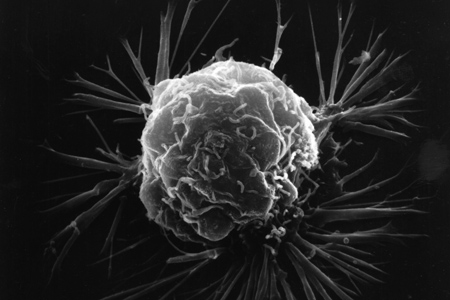현재 위치:홈 > 뉴스현황 > Press Events > Advanced Nanodot Sys...
저자: 업로드:2017-08-28 조회수:
Researchers at Sanford Burnham Prebys Medical Discovery Institute (SBP) have developed a proof-of-concept nanosystem that dramatically improves the visualization of tumors. Their study ("In Vivo Cation Exchange in Quantum Dots for Tumor-Specific Imaging"), published in Nature Communications, the platform achieves a five-fold increase over existing tumor-specific optical imaging methods. The novel approach generates bright tumor signals by delivering "quantum dots" (QDs) to cancer cells without any toxic effects.
"In vivo tumor imaging with nanoprobes suffers from poor tumor specificity. Here, we introduce a nanosystem, which allows selective background quenching to gain exceptionally tumor-specific signals," write the investigators. "The system uses near-infrared quantum dots and a membrane-impermeable etchant, which serves as a cation donor. The etchant rapidly quenches the quantum dots through cation exchange (ionic etching) and facilitates renal clearance of metal ions released from the quantum dots."
"Tumor imaging is an integral part of cancer detection, treatment, and tracking the progress of patients after treatment," says Kazuki Sugahara, M.D., Ph.D., adjunct assistant professor at SBP and adjunct associate research at Columbia University. "Although significant progress has been made in the last two decades, better and more sensitive detection, such as the method we are developing, will contribute to more personalized and potentially more effective interventions to improve the clinical outcomes of cancer patients."

QDs are very small
particles that release fluorescent signals when exposed to light and an
"etchant" that eliminates background signals. They are administered
intravenously, and some leave the bloodstream and cross membranes, entering
cancer cells. Fluorescent signals emitted from excess QDs that remain in the
bloodstream are then made invisible by injecting the etchant.
"The novelty of our nanosystem is how the etchant works," adds researcher Gary Braun, Ph.D. The etchant and the QDs undergo a "cation exchange" that occurs when zinc in the QDs is swapped for silver in the etchant. Silver-containing QDs lose their fluorescent capabilities, and because the etchant can't cross membranes to reach tumor cells, the QDs that have reached the tumor remain fluorescent. Thus, the entire process eliminates background fluorescence while preserving tumor-specific signals, explains Dr. Braun.
The research involved mice
with human breast, prostate, and gastric tumors. The QDs were delivered using
iRGD, a tumor-penetrating peptide that activates a transport pathway that
drives the peptide along with bystander molecules--here, fluorescent QDs--into
cancer cells.